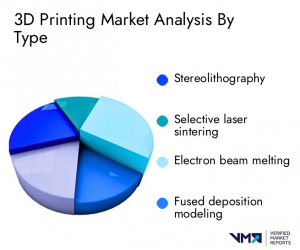3D Printing Market size worth USD 105.97 Billion, Globally by 2030, growing at a CAGR of 24.8% : Verified Market Reports
The report provides an in-depth analysis of the global 3D Printing Market, including its growth prospects, opportunities, market trends and market challenges.
LEWES, DELAWARE, UNITED STATES, August 6, 2024 /EINPresswire.com/ -- According to a new research report published by Verified Market Reports, The Global 3D Printing Market1 size is expected to reach USD 105.97 Billion by 2030, growing at a CAGR of 24.8% during the forecasted period 2024 to 2030.The global 3D printing market refers to the industry focused on the production and sale of 3D printing technologies, including hardware, software, and materials that enable the creation of three-dimensional objects from digital designs. This market is driven by several key factors: the increasing demand for rapid prototyping across industries like automotive, aerospace, and healthcare; advancements in material science, allowing for a broader range of printable materials such as metals, polymers, and ceramics; and the growing adoption of 3D printing for end-use production, particularly in the manufacturing sector. Additionally, the reduction in costs of 3D printing technologies and materials, along with innovations like multi-material and multi-color printing, have made these technologies more accessible to small and medium-sized enterprises (SMEs) and individual consumers. The market is further propelled by the integration of AI and IoT, enhancing precision and efficiency in 3D printing processes.
Download Full PDF Sample Copy of 3D Printing Market Research Report @ https://www.verifiedmarketreports.com/download-sample/?rid=34140
Trends in the Global 3D Printing Market
1. Increased Adoption in Manufacturing: The use of 3D printing in manufacturing, especially for prototyping and custom parts, is growing. Companies are leveraging this technology for faster production cycles and cost-effective small-batch manufacturing.
2. Advancements in Materials: New materials like bioplastics and metal alloys are expanding the applications of 3D printing. These advancements enable the production of more durable and specialized components, enhancing the technology's versatility.
3. Expansion into New Industries: 3D printing is increasingly used in sectors like healthcare, aerospace, and automotive for complex, customized solutions. The technology's ability to create intricate designs is particularly valuable in these high-precision industries.
4. Sustainability Focus: The market is witnessing a shift towards sustainable practices, including the use of recyclable and biodegradable materials. Companies are also exploring ways to reduce waste through additive manufacturing processes.
Challenges in the Global 3D Printing Market
1. High Initial Costs: The upfront costs of 3D printers and materials remain a significant barrier for many businesses. This challenge is particularly acute for small and medium-sized enterprises looking to invest in advanced 3D printing technology.
2. Limited Material Options: Despite advancements, the range of materials suitable for 3D printing is still limited compared to traditional manufacturing. This limitation affects the technology's applicability in certain industries and for specific products.
3. Intellectual Property Concerns: The ease of copying and distributing 3D designs raises significant intellectual property issues. Companies worry about protecting their designs and technologies from being replicated without authorization.
4. Regulatory Hurdles: The lack of standardized regulations and certification processes for 3D-printed products poses challenges. This issue is particularly relevant in industries like healthcare, where safety and compliance are critical.
Keyplayers in the 3D Printing Market
The global market including some of the Top 3D Printing Market Companies such as 3D Systems, Arcam, Autodesk, Stratasys, ExOne, Hoganas, Optomec, Organavo, Ponoko, Voxeljet.
3D Printing Industry Advancements:
• Multi-Material and Multi-Color Printing: One of the significant advancements in the 3D printing industry is the development of printers capable of using multiple materials and colors simultaneously. This innovation allows for more complex and functional prototypes, integrating different materials like plastics, metals, and composites in a single print. It enhances the ability to create multi-functional components, reducing the need for assembly and post-processing. Industries such as consumer goods, automotive, and healthcare benefit greatly from this technology, as it enables the production of intricate designs with varied material properties.
• Enhanced Software and Simulation Tools: The development of advanced software and simulation tools is revolutionizing the 3D printing landscape. These tools provide better design optimization, allowing for the prediction and correction of potential issues before actual printing. Features like topology optimization, generative design, and real-time monitoring have become more accessible, enabling designers to create more complex and lightweight structures. This advancement is particularly beneficial in aerospace and automotive industries, where precision and weight reduction are critical. Enhanced software capabilities also streamline the workflow, making 3D printing more user-friendly and accessible to non-experts.
• Bioprinting and Medical Applications: 3D Bioprinting3 has emerged as a groundbreaking advancement within the 3D printing sector, particularly in the field of medical applications. This technology allows for the printing of complex tissues, organs, and even bones using bio-compatible materials. While still in the research and development phase, 3D bioprinting holds the potential to revolutionize healthcare by providing personalized medical solutions, such as patient-specific implants and prosthetics. Moreover, it offers a promising avenue for drug testing and tissue engineering, potentially reducing the need for animal testing and expediting the development of new medical treatments.
3D Printing Market Segments Insights
Insights by Type
• Stereolithography
• Selective laser sintering
• Electron beam melting
• Fused deposition modeling
• Laminated object manufacturing
Insights by Application
• Consumer products
• Aerospace
• Industrial
• Automotive
• Healthcare
• Defense
• Education & research
Regional Growth Potential of the Global 3D Printing Market
The Asia-Pacific region, particularly China, Japan, and South Korea, shows significant growth potential in the 3D printing market due to strong industrial bases and supportive government initiatives. The region's rapid adoption of advanced manufacturing technologies, coupled with a burgeoning demand in automotive, consumer electronics, and healthcare sectors, drives this growth. North America, led by the United States, continues to be a major hub for innovation and market expansion, thanks to a well-established manufacturing sector and substantial investment in research and development. In Europe, countries like Germany and the UK are focusing on integrating 3D printing into traditional manufacturing, with a strong emphasis on aerospace and automotive applications. Emerging markets in Latin America and the Middle East are also gaining traction, driven by increased awareness and investments in technology adoption. The global growth is further supported by initiatives promoting local production and reducing supply chain dependencies.
Future Outlook of 3D Printing Market
The global 3D printing market is set for exponential growth, driven by technological advancements, decreasing costs, and expanding applications across various industries. By 2030, the market is projected to reach over $50 billion. Key drivers include the adoption of 3D printing in healthcare for custom prosthetics and bioprinting, automotive for rapid prototyping and lightweight components, and aerospace for complex, durable parts. Asia-Pacific is expected to lead market growth due to strong manufacturing bases in China and Japan, while North America and Europe will continue to innovate with new materials and techniques. Challenges such as regulatory standards, intellectual property concerns, and material limitations persist, but ongoing R&D and increasing investment in sustainable, multi-material printing are likely to mitigate these issues. Overall, 3D printing is set to revolutionize manufacturing, enabling greater customization, efficiency, and innovation.
About Us: Verified Market Reports
Verified Market Reports is a leading Global Research and Consulting firm servicing over 5000+ global clients. We provide advanced analytical research solutions while offering information-enriched research studies. We also offer insights into strategic and growth analyses and data necessary to achieve corporate goals and critical revenue decisions.
Our 250 Analysts and SMEs offer a high level of expertise in data collection and governance using industrial techniques to collect and analyze data on more than 25,000 high-impact and niche markets. Our analysts are trained to combine modern data collection techniques, superior research methodology, expertise, and years of collective experience to produce informative and accurate research.
Mr. Edwyne Fernandes
Verified Market Reports
+1 650-781-4080
email us here
Visit us on social media:
Facebook
X
LinkedIn
YouTube
1 https://www.verifiedmarketreports.com/product/global-3d-printing-market-size-and-forecast-to-2025/
2 https://www.verifiedmarketreports.com/download-sample/?rid=34140&utm_source=EINPresswire&utm_medium=018
3 https://www.verifiedmarketreports.com/product/3d-bioprinting-market-size-and-forecast/



